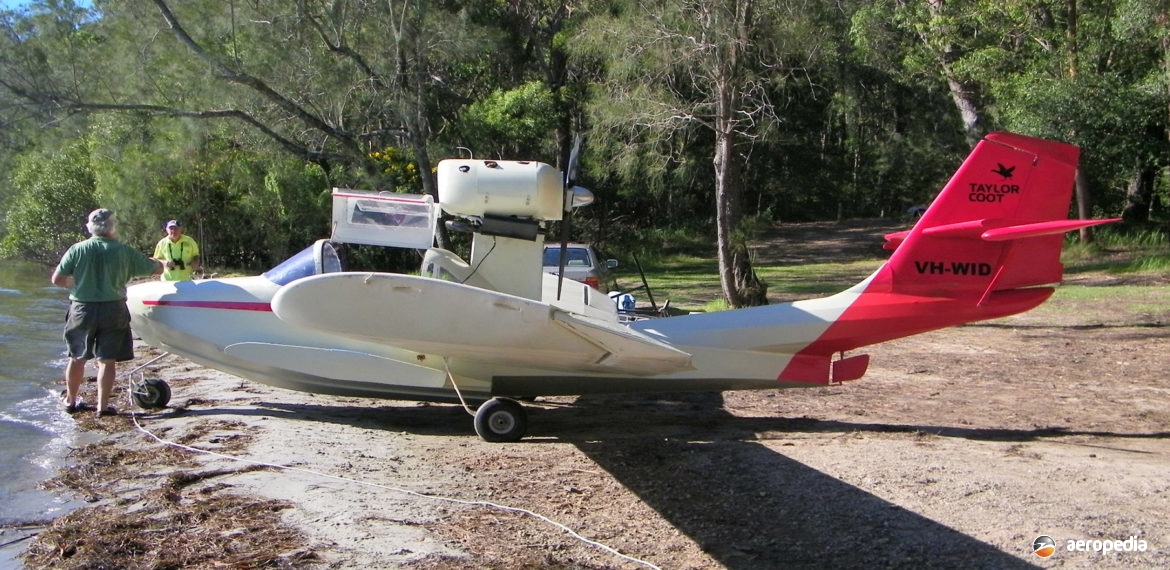Photograph:
Taylor Coot VH-WID (c/n WJC003) at Queens Lake, NSW in March 2013 (W J C Coote)
Country of origin:
United States of America
Description:
Two-seat light amateur-built sport amphibian
Power Plant:
One 134 kw (180 hp) Franklin 335 six-cylinder horizontally-opposed air-cooled engine
Specifications:
- Wingspan: 10.97 m (36 ft)
- Length: 6.71 m (22 ft)
- Height: 2.44 m (8 ft)
- Wing area: 16.72 m² (180 sq ft)
- Max speed: 223 km/h (139 mph)
- Max cruising speed: 209 km/h (130 mph)
- Stalling speed in landing configuration: 72 km/h (45 mph)
- Max rate of climb at sea level: 305 m/min (1,000 ft/min)
- Take-off distance: 183 m (600 ft)
- Range: 966 km (600 miles)
- Fuel capacity: 170 litres (37 imp gals)
- Empty weight: 658 kg (1,450 lb)
- Payload weight: 318 kg (700 lb)
- Loaded weight: 975 kg (2,150 lb)
History:
Designed by Moulton B ‘Molt’ Taylor in 1969, the first of two prototypes of this series (registered N1070) flew for the first time in February 1971 and was known as the Coot Model A. Fitted with a 90 kw (120 hp) Franklin 225 engine, the aircraft completed 100 hours of flying before being re-engined with the up-rated Franklin 335. Subsequently the type was re-named the Sooper-Coot Model A, and plans were made available to amateur constructors. Taylor designed a number of other aircraft, including the Aerocar and the Mini-Imp. The type has also been known and marketed as the Aerocar Sooper Coot Model A, and in later years plans became available through Richard Steeves of Madison, Wisconsin.
A number of kits have been imported to this region over the years. The first completed in Australia became VH-WID² (c/n WJC002) registered on 28 October 2010 to William Coote of Laurieton, later Toronto, NSW. Construction of this aircraft commenced in New Zealand and the project was imported to Australia and, fitted with a 2.5 litre Subaru WRX engine, was completed in 2011. The aircraft at one stage was registered as an Aerocar Sooper-Coot Model A and was said to be fitted with a Textron Lycoming O-320A2B engine driving a Bishton two-blade wood propeller. After completing about 15 hours testing at Camden Haven and Taree, NSW, Mr Coote retired the aircraft and commenced construction of a Periera Osprey II which was a partially completed aircraft from South Australia. Ownership of the Coot was changed to Glen Folan of Yarra Glen, VIC on 31 March 2014.
Examples completed in New Zealand included: ZK-ECL (c/n AACA/128) in 1978, a Coot IA built in Kerikeri and registered on 18 September 1975 fitted with a Franklin engine. It was damaged in an accident on 10 February 1979 during a precautionary landing. It was sold to an owner in Auckland on 6 September 1991 and a turbocharger was fitted in 2000. Since 15 March 2004 it has been owned by Mr M G Farrand of Auckland.
ZK-JST (c/n AACA/108) was allotted the registration ZK-DVM but it was not taken up. It was completed by Alistair McLauchlan and registered on 23 October 1986. It had Micro Aviation Bantam seats and a lowered canopy to reduce height. Ownership was transferred to Peter Hall of Auckland on 6 November 2011.
ZK-FEF (c/n AACA/003), a Coot IA was registered to Mr G Astley of Auckland on 17 November 1982 and was fitted with a Lycoming O-320 engine. It had an incident at Dairy Flat on 29 December 1983, and another at Lake Taharoa, Dargaville on 29 March 1996 which required a rebuild. Owners subsequently included Alan Coubray of Clevedon, Auckland in September 1990, and Martin Farrand of Auckland in July 1993. The port engine cowling separated during flight near Dairy Flat on 18 August 1993 and the aircraft was withdrawn from service in August 1998.
Two others are known to have commenced construction in New Zealand. Construction of ZK-DVK (c/n M16) commenced with Mr R Smith of Paihia in the early 1970s but ceased in 1977 and the registration was not taken up. Construction of ZK-DVL (c/n AACA/233) was commenced in the 1970s with Mr M Moriarty of Papatoetoe but was not completed. As noted ZK-DVM (c/n AACA/108) was commenced and this later became ZK-JST. The Australian aircraft could have been either c/n M16 or AACA/233, neither of which is known to have been completed.
The basic structure was of wood. The tailboom and tail unit were built of steel tube with fabric covering, although they could be completed of all wood monocoque, or all-metal. Some components were made of glass-fibre, such as the covering around the hull, the wing roots and wing leading-edges. The aircraft had a retractable tricycle undercarriage, and the wings could be folded for storage. Some of the components, such as the engine cowl, hull shell, foredeck, instrument panel, engine cooling fan blades and undercarriage legs, were available from the designers in the United States, along with the plans.
The configuration of the Sooper-Coot with the “float-wing” feature, as it was called, permitted the aircraft to operate on rough water and, since the close proximity of the wings to the water formed a pressure wedge, unusually low take-off and landing speeds were possible without recourse to flaps or other devices. Other engines fitted to the Sooper-Coot included the 157 kw (210 hp) Continental IO-360, and the Avco Lycoming O-320 and O-320B units producing 119 kw (160 hp).
In addition to the aircraft completed in Australia and New Zealand, 39 have been completed in the United States and 15 in Canada.

